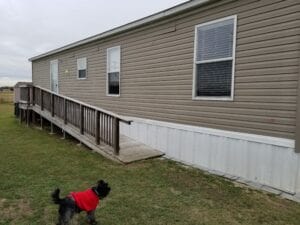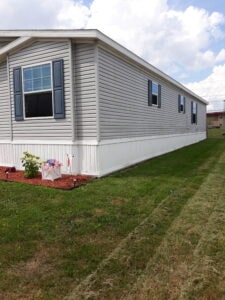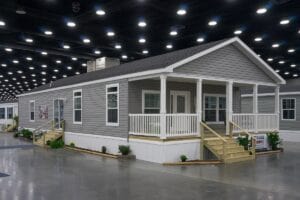Mobile home foundations are important. Especially if you are thinking of moving into a mobile home? You have probably spent a lot of your focus on how many bedrooms you want, how many bathrooms you want, and what style you would like to have. These are all important considerations when choosing any type of home. But there is an often-overlooked aspect when it comes to selecting a mobile home. Have you given any thought into what type of mobile home foundation you want for your home to have?
Mobile Home Foundation

Unlike traditional homes, mobile homes can utilize a variety of foundation types. This is typically less of a concern for renters, but if you are going to be buying your mobile home, you are going to want a mobile home foundation that can stand the test of time. Today, we are going to take a look at the top 6 mobile home foundation types and what they offer.
Mobile Home Foundation : Slab
This is considered one of the most popular mobile home foundation types. This is the practice of using strategically placed solid steel beams to provide support. After the support is in place, skirting is placed around the mobile home foundation. These piers typically set on a slab foundation to keep the mobile home level. This is an extremely popular build and very common in mobile home parks. This kind of mobile home foundation works best for flat lots and is not a good choice for any lot that is sloped or has any kind of curvature. Once the mobile home is up on the piers it can be skirted with a material of your choice.
If you are looking for different types of underpinning or skirting check out our article called Underpinning Mobile Home here

While popular, the pier and beam mobile home foundation type does have a couple of drawbacks. The biggest issue is that this kind of build is not energy efficient. It is very easy for cold weather to get under the home. This can increase your heating bill and also lead to pipe breakage. However, this method is still popular because the beams are anchored into the ground which protect the home from wind and other elements.
Treated Wood: Mobile Home Foundation
Treated wood mobile home foundations are inexpensive and pretty easy to build. These two factors have led to its popularity but be careful if you are considering this kind of foundation. Wood foundations are notorious for weathering quickly. When you use wood, you are subjecting the foundation of your mobile home to water damage which can be extensive, even in so-called “water-proof” solutions. Using wood also means your foundation is more susceptible to termites which can destroy your property. Out of all the options available, wood may sound like a cheap and easy option, but you will probably end up regretting it over time.
These types of foundations can be painted to enhance the look of the home as well as displayed below. Check out Behrs exterior paint for a great paint that will last for years.

Mobile Home Permanent Foundation:
When considering placing your mobile home on a permanent foundation there are a few options to choose from. Each option has it advantages and disadvantages. Just remember these options are not a great choice if you decide you may want to move your mobile home later on.
So what is considered a permanent foundation for a mobile home?
Here are some options:
Cinder Block Foundation
There are many advantages to using a cinder block foundation for your mobile home. The first being, they hold up for years. If you are looking for durable, cinder block is a great choice. Another great feature is the fact that weather does not creep into the home. You can regulate your home temperature much better and not have to worry about the cold freezing your home!
Cinder block foundations add great curb appeal to your home as well. Faux Panels can be installed over top of the cinder block that make it look more elegant as well. See these great panel ideas here.
Lastly, one of the biggest advantages to using cinder block for your mobile home is how it is categorized. Mobile homes built on cinder block are eligible to have their title retired and it is treated like a residential home. That is a huge perk to most. This option is typically only available on private property when you own the land.
Be sure if you do a poured foundation or a cinder block foundation you consider using a crawl space vapor barrier to protect foundation and mobile home.

Concrete Foundation for These Homes
Poured wall foundations are a more expensive option, but certainly has its benefits. Not only is it a very sturdy option for a mobile home, but it may also help you out in the long run. If you plan to ever build a traditional stick-built home in the future, you can use this very same foundation to do it.
Basement Mobile Home Foundation
Looking for more space in your mobile home? You may want to consider using a basement foundation. These types of foundations are built with not only a structural support system, but offers you more square footage for your home. If you are buying a mobile home, but feel like you might be short on space, this can be a great option. Have a separate bedroom, living room or bonus room in your basement to increase the size of your living space. This type of build is ideal for large families or those who need a separate office or studio at home.

Mobile Home Crawl Space Foundation
Crawl space foundations are not all that different from a basement foundation, but there are definite distinctions. This is a less expensive option since you do not get a traditional basement. While a crawl space foundation does not provide you with an entire extra room like a basement, you will get some extra storage, which can make a big difference for some.
This type of build is like the pier and beam model, so it does provide a sturdy foundation. It can hold the weight of the mobile home simply fine while keeping the home off the ground.
The typical size of the crawl space added is roughly 48 inches. Again, it is no basement, but if you need the extra storage, this is a great way to keep your things in a safe and secure space.
One of the downsides to the crawl space foundation is that it will be more susceptible to floods. Also, this type of build is very time consuming. Not only do you have to build the structure and support, but you also are excavating the land to construct the crawl space. It is a more expensive option than some of the others, but if you truly need extra storage the investment is well worth it.
Cost to Put a Mobile Home on a Foundation
Another thing to consider when doing a permanent foundation is the cost to get the home onto the foundation as well. When it comes to a poured wall foundation you have to have the mobile home lifted or rolled onto the foundation which costs extra money. Especially if you are looking to put the mobile home on a basement. Just getting a crane to a property location to lift a mobile home up on a foundation can cost $10k – $15k depending on the area.

As you can see, there are many different options for creating your mobile home’s foundation. Each offers its own pros and cons. However, it is important when choosing a foundation that you take into consideration your family’s needs as well as the type of land you have to build upon.
Foundation Requirements
Make sure you first inquire about zoning laws in your area. This is important if you are setting your mobile home on private land. Rules can vary drastically from city and county, so you need to definitely do your homework. You can typically just Google your county office and find your building inspector to see what they require.
Can You Move a Mobile Home on a Permanent Foundation
You might have purchased a piece of property with a mobile home on the land. If it sits on a foundation just know that you can still move these mobile homes. If you received a property deed with no title to the mobile home check with your local courthouse. There should be paperwork filed there that abolished the title to the home. The courthouse should be able to help you.
Once you have your mobile home set consider Mobile Home Anchors to secure it to your foundation.
Mobile Home Foundation: Conclusion
Hopefully, this guide to foundations will help you make your decision to create the best mobile home foundation for your future home!
FAQ’s: Mobile Home Foundation
What foundation is best for a mobile home?
A pier and beam foundation, which involves concrete piers supporting the home, is often considered one of the best foundations for a mobile home. It provides stability and allows for leveling adjustments over time.
What is the cheapest permanent foundation for a mobile home?
The cheapest permanent foundation for a mobile home is typically a concrete block or concrete slab foundation. However, the specific costs can vary depending on local regulations and the site’s characteristics.
How do you prepare the ground for a mobile home?
To prepare the ground for a mobile home, you should level and compact the soil, remove any debris or vegetation, and create a firm, stable surface. Additionally, you may need to install footings or piers for the home’s foundation.
Can I put a mobile home on my property?
Whether you can put a mobile home on your property depends on local zoning regulations, land use laws, and any covenants or restrictions that may apply. It’s important to check with your local planning or zoning department and ensure compliance with all relevant regulations before placing a mobile home on your property.
